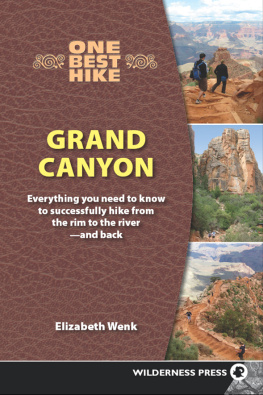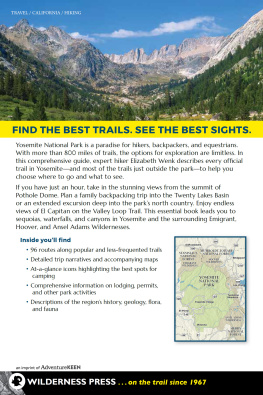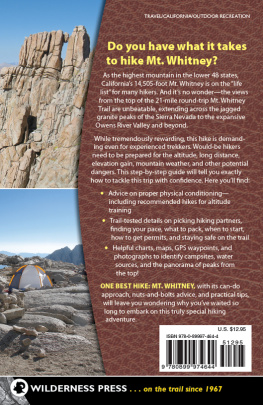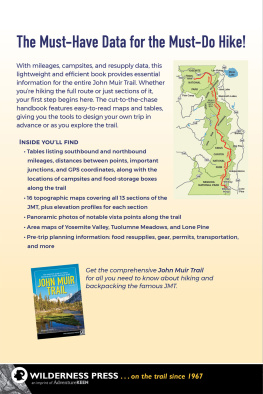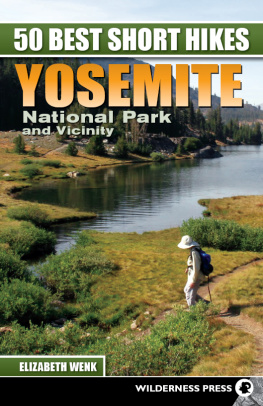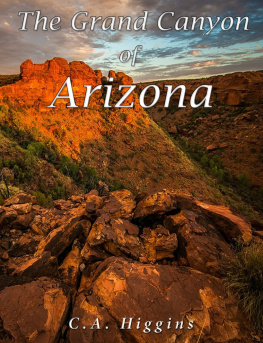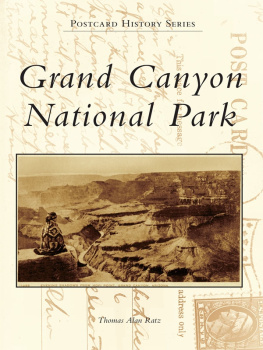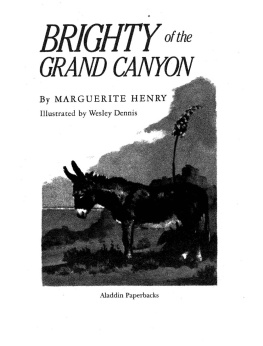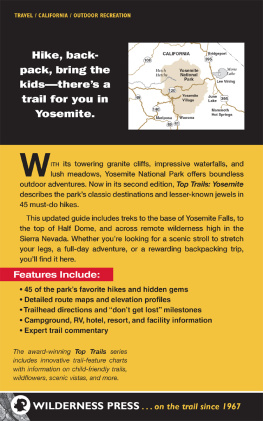



One Best Hike: Grand Canyon
1st EDITION 2010
Copyright 2010 by Elizabeth Wenk
Cover photos copyright 2010 by the author
Interior photos, except where noted, by the author
Maps and figures: Elizabeth Wenk and Larry B. Van Dyke
Cover design: Larry B. Van Dyke
Interior design: Andreas Schueller and Larry B. Van Dyke
Editor: Laura Shauger
ISBN 978-0-89997-491-0
Manufactured in the United States of America
Published by: | Wilderness Press |
1345 8th Street |
Berkeley, CA 94710 |
(800) 443-7227; FAX (510) 558-1696 |
info@wildernesspress.com |
www.wildernesspress.com |
Visit our website for a complete listing of our books and for ordering information.
Distibuted by Publishers Group West
Front cover photos: Top: Descending below Ooh Aah Point on the South Kaibab Trail; Middle: Walls of Coconino Sandstone rising above the Bright Angel Trail (near 1.5-Mile Resthouse); Bottom: Descending below Cedar Ridge on the South Kaibab Trail
Back cover photos: Top: View from Mather Point; Bottom: Ribbon Falls
Frontispiece: A mule train approaches Jacobs Ladder on the Bright Angel Trail.
All rights reserved. No part of this book may be reproduced in any form, or by any means electronic, mechanical, recording, or otherwise, without written permission from the publisher, except for brief quotations used in reviews.
SAFETY NOTICE: Although Wilderness Press and the author have made every attempt to ensure that the information in this book is accurate at press time, they are not responsible for any loss, damage, injury, or inconvenience that may occur to anyone while using this book. You are responsible for your own safety and health while in the wilderness. The fact that a trail is described in this book does not mean that it will be safe for you. Be aware that trail conditions can change from day to day. Always check local conditions, know your own limitations, and consult a map.
To Eleanor and Sophia,
who were tolerant of our many research
trips to the bottom of the Grand Canyon


Opposite and above: Enjoying the view from Plateau Point
Introduction
Stand at some point on the brink of the Grand Canyon where you can overlook the river, and the details of the structure, the vast labyrinth of gorges of which it is composed, are scarcely noticed; the elements are lost in the grand effect, and a broad, deep, flaring gorge of many colors is seen. But stand down among these gorges and the landscape seems to be composed of huge vertical elements of wonderful form.
John Wesley Powell,
Explorations of the Colorado River and Its Canyons
T he Grand Canyon is one of the most recognizable natural features in the world: It earns a spot as one of the seven natural wonders of the world and is the best-known national park in North America. Five million people visit the Grand Canyon each year to enjoy the incomprehensibly grand views from the rim. However, as John Wesley Powell candidly wrote in 1875, you havent really visited the Grand Canyon until you descend below the rim.
Each time I visit the Grand Canyon and stop at my first rim vista point, I anticipate the indescribably grand view, sit down, and stare in disbelief at the landscape. Can this place really exist? But the view satisfies me for only a short period of time; the rim views have an aerial feel and I want to be on the ground exploring. As I stare at the canyon, my mind begins to travel downward, tracing side canyons, following plateaus, and peering toward the river.
Before long my legs begin to twitchat least figurativelywishing to explore the intricacies of the landscape. In a mountainous wilderness, many people are motivated to hike to a summit to enjoy an otherwise unattainable vista. There are equally hidden vistas buried deep in the canyon: the walls of the Inner Gorge, the views of the inner canyon buttes once you are among them, mesas that merge with the landscape until you are below the rim, and of course the raging river. The landscape feels much more complex once you are in it, rather than looking down on it.
Therefore, dont allow yourself the complacency of sitting on the rim, enjoying the splendid panoramas and believing that you have seen the Grand Canyon. If you have ever stared at a view of the Grand Canyoneven if only a picture of the viewconsider challenging yourself to descend to the bottom of the canyon. The two well-maintained trails, termed corridor trails, descending from the South Rim of the Grand Canyon, the Bright Angel Trail and the South Kaibab Trail allow tens of thousands of hikers to see the inner canyon and reach the Colorado River each year.

A Location Hike
Hiking is more than exerciseit is a time to be outdoors and therefore to absorb your surroundings. I am always a little disappointed to pass people so intent on reaching a destination or staring so closely at the bottoms of their hiking poles that they dont notice the flowers, the rocks, the birds, or the general landscape.
Hikes can be thought of as somewhere on a continuum from destination hikes to location hikes. On a destination hike the sights along the way are overshadowed by those at the end pointmany a summit hike or walk through forest to a spectacular lake fits into this categoryand hikers are mostly forgiven for just trekking to the end. On a location hike, there is something new and spectacular to see every few steps down the trail, yet no single location that is universally judged most beautiful. Hikes in the Grand Canyon are the ultimate location hikes, so plan an itinerary that gives you down timebe that many extra five-minute breaks to see what you pass or an extra day to give you more time to wander around.
WHY YOU SHOULD BUYAND CARRYTHIS BOOK
If you have ever searched for books on the Grand Canyon you were likely overwhelmed by the large number of generally excellent books written on its trails, natural history, human history, accidents, and more, leaving you wondering whether theres space for yet another title. If you wish to read individual books that delve into the regions botany, geology, prehistory, pioneer history, tourist attractions, on-trail hiking, or off-trail exploration, then the suggests a healthy foundation for a Grand Canyon library. However, if you plan to visit the Grand Canyon infrequently (until its spirit captures you and you decide to return often), this book provides you an introduction to most of these topics, all focused on the two corridor trails descending from the South Rim: the Bright Angel and South Kaibab trails.
Next page
